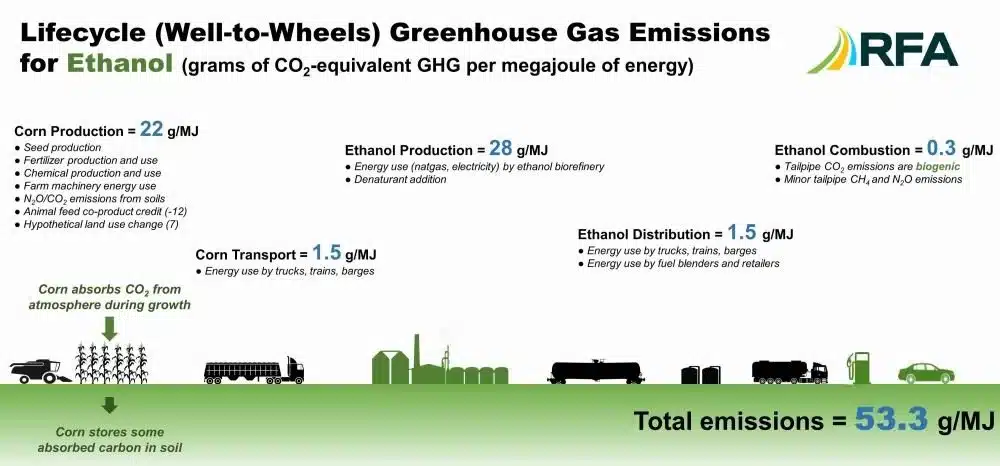Red Trail Energy, (RTE), in collaboration with Puro.earth, has announced the issuance of carbon dioxide (CO2) removal credits on the Puro Registry. This marks a significant milestone as the first ethanol production facility to generate CO2 Removal Certificates (CORCs) in the voluntary carbon market (VCM).
The initiative also represents the largest durable carbon removal project registered to date. Red Trail Energy will make its CORCs available through its marketing arm, RPMG.
Ethanol’s Environmental Impact: A Corn-Based Revolution
Most of the biofuel produced in the United States is ethanol, derived from corn starch and commonly blended into gasoline. About 98% of gasoline sold in the U.S. contains a 10% ethanol blend.
During the early 2000s, energy policy initiatives aimed to enhance energy independence spurred a significant uptick in domestic ethanol production. From 2000 to 2018, U.S. corn ethanol output surged from 1.5 billion gallons to 16 billion gallons.
Initial life cycle assessments (LCAs) estimated that U.S. corn ethanol would yield 20% lower GHG emissions compared to gasoline.

The most recent study commissioned by the Department of Energy (DOE), conducted by Argonne National Laboratory in 2021, revealed that U.S. corn ethanol exhibits 44%–52% lower GHG emissions than gasoline. Gasoline has a carbon intensity of about 89.5 grams of CO2e per megajoule (MJ) of energy delivered.
Argonne’s analysis demonstrated a 20% reduction in carbon emissions from U.S. corn ethanol between 2005 and 2019. This decline can be attributed to advancements in agricultural practices. These include increased corn yields per acre, reduced fertilizer usage, and enhancements in ethanol production processes.
Red Trail Energy’s Pioneering Carbon Capture Efforts
RTE operates a corn ethanol production facility with an annual capacity of 64 million gallons. The CO2 generated during the ethanol fermentation process is captured and stored to prevent its release into the atmosphere.
RTE’s facility is the first of its kind permitted under state regulations to capture and store CO2 in a Class VI well. It can capture and store approximately 180,000 tons of CO2 annually.
The captured biogenic CO2 is injected into an underground Class VI well located beneath the facility for permanent storage. RTE has implemented continuous efforts to minimize the fossil footprint associated with its main product, biofuel, through energy efficiency measures and sustainable agricultural practices.
Red Trail Energy’s project was in partnership with the clean energy advisory firm EcoEngineers and was registered under the Puro Standard. The standard is the leading crediting platform for engineered carbon removal.
The carbon removal credits are generated through bioenergy with carbon capture and storage (BECCS) from ethanol production. They adhere to Puro’s Geologically Stored Carbon Methodology.
Before CORCs issuance, RTE underwent independent verification and met all requirements related to feedstock sustainability, carbon sequestration permanence, and financial additionality.
RTE captures CO2 emitted during the fermentation process at its ethanol plant. Then it sequesters it into a permitted underground Class VI well located approximately 6,500 feet beneath the facility.
The resulting carbon removal credits will be available as CORCs to support buyers in complementing their emission reduction efforts towards achieving net zero targets.
Jodi Johnson, Chief Executive Officer of Red Trail Energy, expressed pride in achieving this milestone, emphasizing the significance of being among the first bioenergy facilities with BECCS and pioneering the provision of verified CDR credits to the market.
Antti Vihavainen, Chief Executive Officer of Puro.earth, said:
“The significance of RTE’s CCS project cannot be overstated, as it serves as a compelling demonstration that through stringent methodologies for carbon removal and the financial incentives from CORCs, the vital infrastructure required for large-scale carbon sequestration will materialize.”
Driving Carbon Removal Forward
With guidance from EcoEngineers and through Puro.earth, RTE received over 150,000 CO2 Removal Certificates from the initial 14 months of operation of its bioenergy with carbon capture and storage (BECCS) project.
David LaGreca, Managing Director of VCM Services at EcoEngineers, emphasized the importance of supporting high-quality removal programs. This is even crucial in the context of global carbon budgets and the imperative to reduce emissions.
The Puro.earth’s CORCs indicate durability of carbon sequestration for over 1,000 years, meeting key environmental criteria for permanence. These CORCs are listed in the International Carbon Reduction and Offset Alliance (ICROA)-endorsed Puro Registry. As such, their traceability and transparency throughout their lifecycle, from issuance to retirement, are high.
Sales of CORCs in voluntary markets are crucial for supporting the development of carbon capture and storage (CCS) projects. They also help mitigate financial risks associated with carbon removal initiatives.
The CORCs generated by RTE comply with rigorous scientific and market requirements, including criteria for additionality and permanence. These CORCs can complement other incentives aimed at reducing carbon emissions.
Red Trail Energy’s collaboration with Puro.earth marks a pivotal moment in ethanol production, pioneering the issuance of carbon removal credits. By capturing and storing biogenic CO2 emissions, Red Trail Energy sets a precedent for sustainable practices, showcasing the vital role of innovative technologies in combating climate change.

